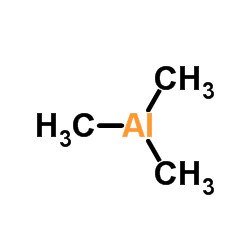trimethylaluminum

trimethylaluminum structure
|
Common Name | trimethylaluminum | ||
|---|---|---|---|---|
| CAS Number | 75-24-1 | Molecular Weight | 72.085 | |
| Density | 0.81 g/mL at 25 °C | Boiling Point | 126 °C | |
| Molecular Formula | C3H9Al | Melting Point | 15 °C | |
| MSDS | Chinese USA | Flash Point | 40 °F | |
| Symbol |




GHS02, GHS05, GHS07, GHS08 |
Signal Word | Danger | |
|
TGF-beta receptor type-2 expression in cancer-associated fibroblasts regulates breast cancer cell growth and survival and is a prognostic marker in pre-menopausal breast cancer.
Oncogene 34(1) , 27-38, (2015) Transforming growth factor-beta (TGF-β) is a pleiotropic cytokine with the capability to act as tumour suppressor or tumour promoter depending on the cellular context. TGF-beta receptor type-2 (TGFBR2) is the ligand-binding receptor for all members of the TGF... |
|
|
Loss of TGFβ Receptor Type 2 Expression Impairs Estrogen Response and Confers Tamoxifen Resistance.
Cancer Res. 75(7) , 1457-69, (2015) One third of the patients with estrogen receptor α (ERα)-positive breast cancer who are treated with the antiestrogen tamoxifen will either not respond to initial therapy or will develop drug resistance. Endocrine response involves crosstalk between ERα and T... |
|
|
Hygroscopic and phase transition properties of alkyl aminium sulfates at low relative humidities.
Phys. Chem. Chem. Phys. 17 , 19789-96, (2015) Alkyl aminium sulfates (AASs) can affect the physicochemical properties of atmospheric aerosols such as hygroscopicity. Previous laboratory experiments have shown that the water content in AAS bulk solutions is higher than in aqueous ammonium sulfate solution... |
|
|
Destabilisation of dimeric 14-3-3 proteins as a novel approach to anti-cancer therapeutics.
Oncotarget 6 , 14522-36, (2015) 14-3-3 proteins play a pivotal role in controlling cell proliferation and survival, two commonly dysregulated hallmarks of cancers. 14-3-3 protein expression is enhanced in many human cancers and correlates with more aggressive tumors and poor prognosis, sugg... |
|
|
Ku80 cooperates with CBP to promote COX-2 expression and tumor growth.
Oncotarget 6 , 8046-61, (2015) Cyclooxygenase-2 (COX-2) plays an important role in lung cancer development and progression. Using streptavidin-agarose pulldown and proteomics assay, we identified and validated Ku80, a dimer of Ku participating in the repair of broken DNA double strands, as... |
|
|
¹H-NMR and MS based metabolomics study of the intervention effect of curcumin on hyperlipidemia mice induced by high-fat diet.
PLoS ONE 10(3) , e0120950, (2015) Curcumin, a principle bioactive component of Curcuma longa L, is well known for its anti-hyperlipidemia effect. However, no holistic metabolic information of curcumin on hyperlipidemia models has been revealed, which may provide us an insight into the underly... |
|
|
Immunohistochemical application of a highly sensitive and specific murine monoclonal antibody recognising the extracellular domain of the human hepatocyte growth factor receptor (MET).
Histopathology 65(6) , 879-96, (2014) Development of novel targeted therapies directed against hepatocyte growth factor (HGF) or its receptor (MET) necessitates the availability of quality diagnostics to facilitate their safe and effective use. Limitations of some commercially available anti-MET ... |
|
|
Loss of 4q21.23-22.1 is a prognostic marker for disease free and overall survival in non-small cell lung cancer.
PLoS ONE 9(12) , e113315, (2014) This study was performed to assess the prognostic relevance of genomic aberrations at chromosome 4q in NSCLC patients. We have previously identified copy number changes at 4q12-q32 to be significantly associated with the early hematogenous dissemination of no... |
|
|
Skin sensitization induced Langerhans' cell mobilization: variable requirements for tumour necrosis factor-α.
Immunology 144(1) , 139-48, (2015) Upon antigen/allergen recognition, epidermal Langerhans' cells (LC) are mobilized and migrate to the local lymph node where they play a major role in initiating or regulating immune responses. It had been proposed that all chemical allergens induce LC migrati... |
|
|
Bioelectronic nose combined with a microfluidic system for the detection of gaseous trimethylamine.
Biosens. Bioelectron. 71 , 179-85, (2015) A bioelectronic nose based on a novel microfluidic system (μBN) was fabricated to detect gaseous trimethylamine (TMA) in real-time. Single-walled carbon nanotube-field effect transistors (SWNT-FETs) were functionalized with olfactory receptor-derived peptides... |